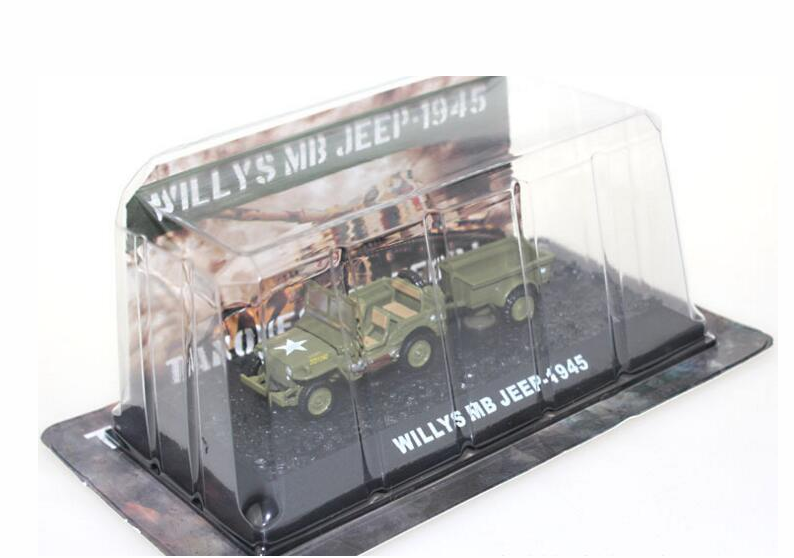old boy hobby
1/72 Scale 1945 Willys MB Jeep with Trailer Military Utility Vehicle Diecast Model
1/72 Scale 1945 Willys MB Jeep with Trailer Military Utility Vehicle Diecast Model
Couldn't load pickup availability
- diecast and pre-painted, ready to display
- material: metal & plastic
- scale: 1/72
- size: 8.5*3*2 cm
The Willys MB and the Ford GPW, both formally called the U.S. Army Truck, 1⁄4 ton, 4×4, Command Reconnaissance, commonly known as the Willys Jeep, Jeep, or jeep, and sometimes referred to by its Standard Army vehicle supply nr. G-503, were highly successful American off-road capable, light military utility vehicles. Well over 600,000 were built to a single standardized design, for the United States and the Allied forces in World War II, from 1941 until 1945. This also made it (by its light weight) the world's first mass-produced four-wheel-drive car, built in six-figure numbers.
The 1⁄4-ton jeep became the primary light, wheeled, multi-role vehicle of the United States military and its allies, with President Eisenhower once calling it "one of three decisive weapons the U.S. had during WWII." With some 640,000 units built, the 1⁄4 ton jeeps constituted a quarter of the total military support motor vehicles that the U.S. produced during the war, and almost two-thirds of the 988,000 light 4WD vehicles produced, when counted together with the Dodge WC series. Large numbers of jeeps were provided to U.S. allies, including the Soviet Union at the time. Aside from large amounts of 11⁄2- and 21⁄2 ton trucks, and 25,000 3⁄4 ton Dodges, some 50,000 1⁄4 ton jeeps were shipped to help Russia during WWII, against Nazi Germany's total production of just over 50,000 Kübelwagens, the jeep's primary counterpart.
Historian Charles K. Hyde wrote: "In many respects, the jeep became the iconic vehicle of World War II, with an almost mythological reputation of toughness, durability, and versatility." Not only did it become the workhorse of the American military, literally replacing the use of horses and other draft animals (still heavily used in World War I), but also motorcycles (and sidecars) in every role, from messaging and cavalry units to supply trains—but improvised field modifications also made the jeep capable of just about any other function soldiers could think of. Moreover, military jeeps were adopted by countries all over the world, to this day—so much that they have become the most widely used and recognizable military vehicle in history.
Dwight D. Eisenhower, the Supreme Commander of the Allied Expeditionary Force in Europe in World War II, wrote in his memoirs that most senior officers regarded it as one of the five pieces of equipment most vital to success in Africa and Europe. General George Marshall, Chief of Staff of the US Army during the war, called the vehicle "America's greatest contribution to modern warfare." In 1991, the MB Jeep was designated an "International Historic Mechanical Engineering Landmark" by the American Society of Mechanical Engineers.
After WWII, the original jeep continued to serve, in the Korean War and other conflicts, until it was updated in the form of the M38 Willys MC and M38A1 Willys MD (in 1949 and 1952 respectively), and received a complete redesign by Ford in the form of the 1960-introduced M151 jeep. Its influence, however, was much greater than that—manufacturers around the world began building jeeps and similar designs, either under license or not—at first primarily for military purposes, but later also for the civilian market. Willys turned the MB into the civilian Jeep CJ-2A in 1945, making the world's first mass-produced civilian four-wheel drive. The "Jeep" name was trademarked, and grew into a successful, and highly valued brand.
The success of the jeep inspired both an entire category of recreational 4WDs and SUVs, making "four-wheel drive" a household term, and numerous incarnations of military light utility vehicles. In 2010, the American Enterprise Institute called the jeep "one of the most influential designs in automotive history." Its "sardine tin on wheels" silhouette and slotted grille are perhaps even more instantly recognizable than the VW Beetle or the Mini, and it has evolved into the currently produced Jeep Wrangler still largely resembling the original jeep design.
--copied from Wikipedia
Share








